Gastrophysics and Intellectual Property Law: Analyzing the Legal and Market Effects of a Reimagined Form of Culinary Art and Science
By

By
Mark Edward Blankenship Jr.[1]*
In 2014, University of Montana Law Professor Cathay Y.N. Smith published an article with the John Marshall Review of Intellectual Property Law on food plating, the art of food presentation, and its implications in intellectual property law.[2] In that article, she proposes three questions: (1) whether artistic food plating could fulfill copyright’s requirement of being an original work of authorship fixed in a tangible medium of expression containing artistic aspects separable from its utilitarian functions; (2) whether artistic food plating could function as protectable trade dress that is nonfunctional and able to acquire secondary meaning; and (3) whether artistic food plating could be protectable as new, original, ornamental, and nonobvious design patent.[3] She concluded that a chef may not be able to copyright her artistic food presentation because of copyright law’s fixation and conceptual separability requirements, but—in limited circumstances—a chef may be able to claim trademark protection of a signature dish, or apply for a design patent for her ornamental plating arrangement.[4]
This particular article, as well as many others[5] that discuss the relationship between intellectual property and food design, does not take into consideration the emerging study of gastrophysics, in which food plating plays a small part.[6] My law review article with the Wake Forest Journal of Business & Intellectual Property, discusses how the gastrophysics concept of sonic seasoning has affected the craft beer industry, and the ways in which intellectual property law can have a pivotal role to play.[7]
However, in light of the evolving trends and trajectories of how this science can be best understood, this Article hopes to discuss the concept of gastrophysics as a whole and a few legal implications it may bring regarding commercialization and the intellectual property protection of food design.[8]
To begin, it is important to understand the study of gastrophysics and its origins before diving into the intellectual property aspects this science might raise.
Essentially, gastronomy and gastrophysics cover food from cultivation to processing, cooking, the food itself, eating, and integration with the human senses and body.[9] The relation between gastrophysics and gastronomy is akin to the relation between astrophysics and astronomy. Astronomers observe planets and stars, and describe where they are and how they move. Astrophysicists explain why the planets and stars are where they are, and how they got there. Likewise, gastrophysics essentially aims to explain the general scientific nature of gastronomy.[10]
In 1825, French lawyer and culinary connoisseur Jean Anthelme Brillat-Savarin, defined “gastronomy” in his book, Physiologie du goût (The Physiology of Taste), as “the knowledge and understanding of everything that relates to humankind as feeding animals.”[11] Today, “gastronomy” is broadly defined as the art, cultural history, and science of good cooking.[12] A wide range of established scientific disciplines relate to gastronomy, in particular food chemistry and technology, sensory sciences, and human nutrition.[13]
Gastrophysics is the scientific and molecularly based subdiscipline that combines soft matter physics and chemistry, culinary sciences, food chemistry, and molecular gastronomy.[14] Gastrophysicists have intriguingly studied the effects of food preparation, the raw materials of food, and quantitative aspects of the physical basis for food quality, bodily absorption, and the aestheticism of flavor.[15] More particularly, gastrophysics involves the complex connection between (1) the factors that affect the overall sensory experience of eating, such as taste, touch, and scent, etc., (2) the chemical and physical composition of the food, and (3) how the food is consumed.[16] In short, gastronomy demonstrates to the public what makes food delicious and enjoyable, whereas gastrophysics explains why.[17]
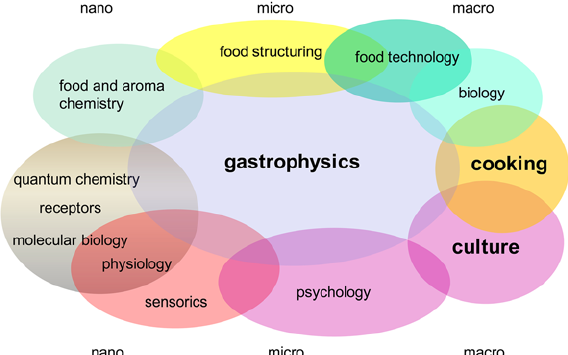
Figure 1: Venn Diagram Demonstrating the Scope of Gastrophysics.
As of now, there are a couple of primary subareas of gastrophysics that have greatly inspired product brands, culinary artists, and other creators. These will be explained below.
One scientific phenomenon that has gained recent exposure when it comes to capturing elements of consumer cognition is the application of sonic seasoning into food and beverage production.[18] Based on Dr. Septimus Piesse’s olfactory pyramid model, which demonstrated a multisensory relationship between sound and smell, sonic seasoning is the concept that sound may have a cross-modal effect on one’s perception of taste.[19] In my previous article, I discussed how “the interaction between two or more senses, or sensory modalities, can add significant value to a person’s dining or consuming experience.”[20] I then indicated that factors “such as the way music is composed to the way tonalities, dynamics, and studio techniques are emphasized and recorded may all impact how food tastes when music is played.”[21]
Technology has been a crucial component in exploring the subgenre of sonic seasoning. Charles Spence, one of the most notorious pioneers in the study of gastrophysics, was awarded the Ig Nobel Prize for Nutrition in 2008 for his “Sonic Chip” experiment.[22] Using a soundproof booth, a pair of headphones, an amplifier, an equalizer, and nearly two hundred Pringles, Spence’s experiment was the first to successfully demonstrate how sound could alter the taste of food.[23] This experiment inspired gastrophysicists and other culinary innovators to use technology and other soundscapes with various forms of food and drink,[24] such as seafood,[25] coffee,[26] and even alcohol.[27] Since the release of Blankenship’s sonic seasoning article, more alcohol brands have introduced their own beverage/playlist combinations.[28]
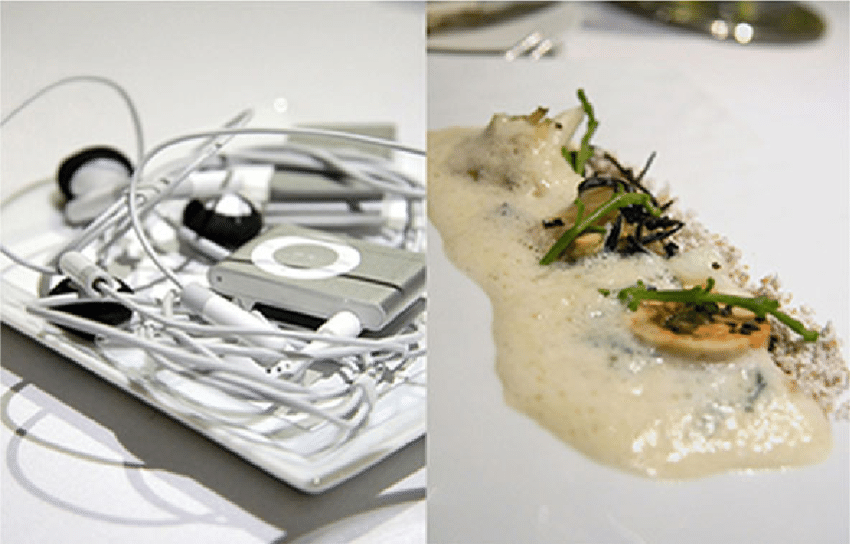
Figure 2: Heston Blumenthal, Sounds of the Sea (2013).
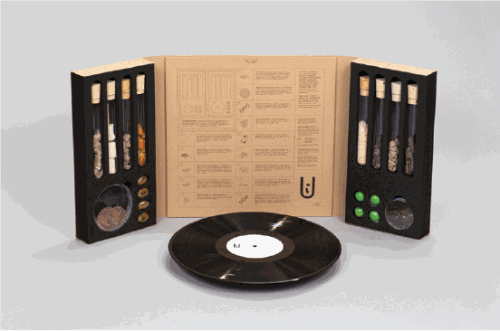
Figure 3: Anthony Dunn, Unusual Ingredients (2020).
Other researchers have demonstrated that a variety of visual factors, such as the color and balance of the elements on a plate, can influence a diner’s perception of, and response to, food.[29] For example, Franco-Colombian chef Charles Michel created a salad based on Kandinsky’s Painting number 201, which has been displayed at the Museum of Modern Art in New York.[30]
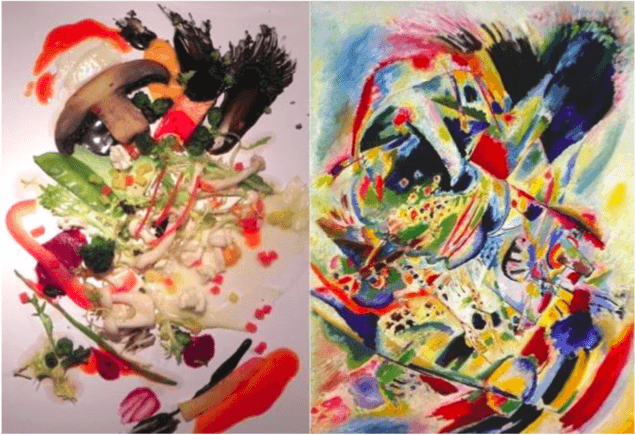
Figure 4: Kandinsky Salad (left, courtesy of chef Charles Michel), and the painting on which it was based (right, Kandinsky’s “201”).

Figure 5: Jehengir Mehta demonstrating the Instagrammability of food served on the hand (2017).
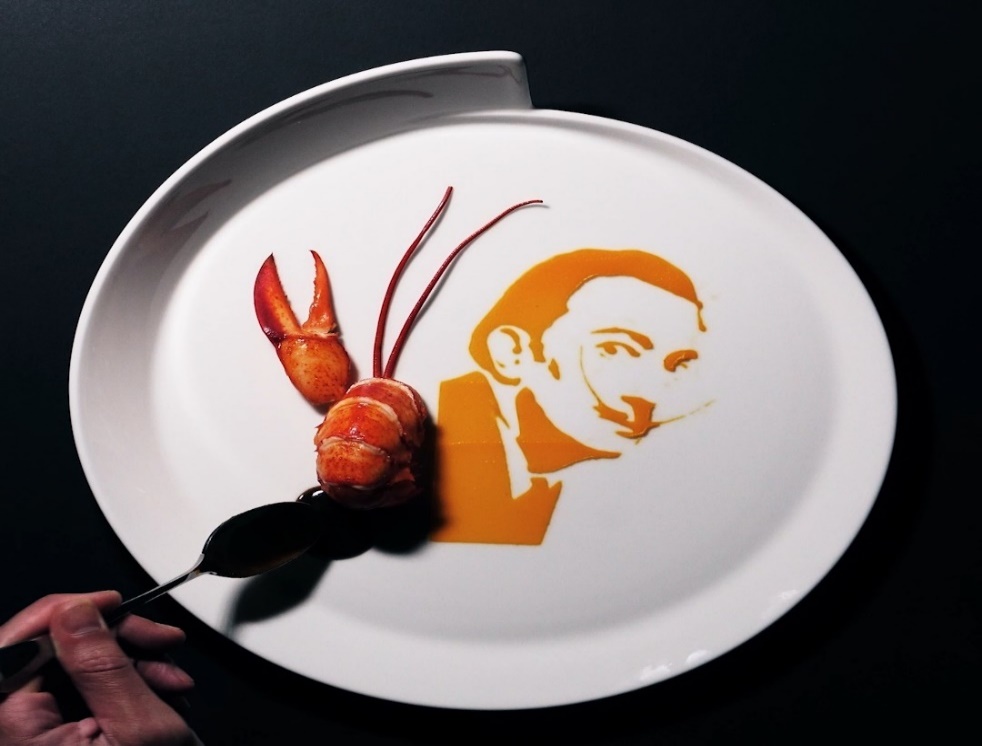
Figure 6: Jozef Youssef, Dali (2020).
The International Journal of Food & Design had called for article submissions regarding the clear definition and the doctrinal trajectory of gastrophysics:[31]
Given the aims and scope of the journal, we were particularly interested in receiving those articles that incorporated applied insights and aspects of design. More specifically, we were interested in those works that looked to integrate food design with other disciplinary approaches, such as experimental psychology, cognitive neuroscience, design, marketing, economics, anthropology and culinary arts, among others, in the context of gastrophysical investigation. As gastrophysics aims to expand our knowledge on the phenomena observed in relation to gastronomy, we are also interested in evidence-based solutions to urgent human and planetary health issues. Our hope is that at the intersection of science, technology and design we can foster awareness, behavioural change and inspire novel strategies for innovation in the food industry that are so urgently needed.[32]
Upon reflection of the submissions received, the editors of the journal decided that more creative endeavors with food should be investigated.[33] While these editors and scientists recognized that food science was undoubtedly a part of the solution, they firmly believed that food design and culinary artistry also constitutes another crucial element.[34] Below are a couple of new technological developments that may be useful in evolving food design and culinary artistry.[35]
Currently in the food industry, blockchain technology has been primarily used for food safety, food quality, food fraud, food defense, and food security.[36] One potential method in which gastrophysics could evolve is through non-fungible tokens (NFTs), which are non-interchangeable pieces of information that are stored in a blockchain that can be sold, shared, or traded accordingly.[37] NFTs are unique and unchangeable digital assets, such as art, music, and videos, that can be bought and sold with cryptocurrency.[38] Several alcohol brands, such as Bacardi, Hennessey, and Budlight, have already began their own NFT projects.[39]
The exchange of NFTs, in collaboration with the Metaverse, allows multiple industries to expand their business and is not just an opportunity for the gamification of their food business.[40] Foodverse can serve as a unique environment for various food enthusiasts, business owners, chefs, and companies to:
Wearable technology can act as a link between the customer and digital marketing for food and beverage in a way that augments reality and provides a new experience in sales and consumption.[42] Gastrophysics can definitely be revolutionized through the implementation of artificial intelligence, e‑commerce, and mobile apps.[43] For instance, University of Ljubljana Professor Mojca Ramšak refers to several examples of this multisensory phenomena, such as smart packaging,[44] the use of Google Glasses in enhancing the winetasting experience,[45] and the use of social media to create digital wine storytelling.[46]
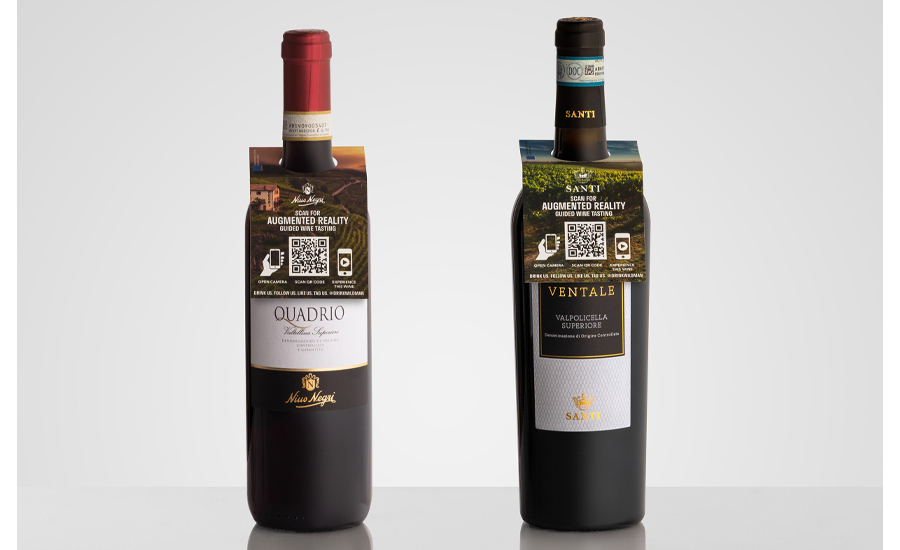
Figure 7: Demonstrating wines with smart labels that provide augmented reality wine tasting tours.
Trade secrets play a major role in the food and beverage industry, particularly in relation to the equipment, the ingredients and raw materials used, processes, sources, pricing strategies, and contact lists.[47] A trade secret is any information, including a formula, pattern, compilation, program, device, method, technique, or process, that (1) derives actual or potential independent economic value from not being generally known to, and not being readily ascertainable by proper means by, other persons who can obtain economic value from its disclosure or use, and (2) the holder of such information has made reasonable efforts to keep it secret.[48] Misappropriation involves the acquisition of a trade secret by improper means or the knowing unauthorized disclosure or use of a trade secret that was acquired by accident or mistake.[49] While trade secrets have been viewed as a form of intellectual property with the least amount of protection, trade secret assets have the potential to become the biggest economic driver for the United States in a world that promotes “copying” technology rather than “innovation.”[50]
The United States Constitution expressly conditions the grant of power in the patent and copyright clause on a particular end, namely “to Promote the Progress of Science and useful Arts.”[51] Section 101 of the Patent Act states, “Whoever invents or discovers any new and useful process, machine, manufacture, or composition of matter, or any new and useful improvement thereof, may obtain a patent therefor, subject to the conditions and requirements of this title.”[52]
While gastrophysical phenomena is an intriguing discovery, it is unlikely to be eligible for patentability. The Patent Act defines several broad categories of inventions that qualify for protection. An invention must be a “process, machine, manufacture, or composition of matter.”[53] The term “process” is defined as “process, art or method, and includes a new use of a known process, machine, manufacture, composition of matter, or material.”[54]
In 2010, the United States Supreme Court (SCOTUS) held that a business method patent claiming a method for hedging risks was ineligible for patent protection because it was generally a patent on an “idea” and that “laws of nature, physical phenomena, and abstract ideas” are not patentable.[56] Rather, they are the “basic tools of scientific and technological work.”[57] Had Bilski been allowed to patent his risk avoidance instructions, it would disallow the use of the strategy in all fields, not just energy commodities, since the avoidance strategy, or hedging, “is a fundamental economic practice long prevalent in our system of commerce . . . .”[58] Thus, a monopoly on such an abstract idea may not be given to one person via a patent.[59]
In Mayo, Defendants purchased from Prometheus Laboratories, Inc. diagnostic tests that embodied two of Prometheus’ patent applications, which described the correlations between administering a thiopurine compound to an individual and determining how a particular dosage could be read to be too low or too high.[61] Several years later, Prometheus filed suit against Mayo for patent infringement after Mayo announced that it intended to sell its own test, using a different thiopurine level to determine toxicity.[62]
SCOTUS held that a patent on a method of optimizing a drug’s efficacy was invalid, because the method’s steps added nothing to the underlying law of nature regarding the relationships between metabolite levels and the likelihood that a dose would be harmful.[63] The Court emphasized that, because methods for making such determinations were well known in the art, this step simply tells doctors to engage in well-understood, routine, conventional activity previously engaged in by scientists in the field.[64] Thus, such activity is normally not sufficient to transform an unpatentable law of nature into a patent-eligible application of such a law.[65]
In Alice, SCOTUS held that a claim that involves an abstract idea is patentable only if the balance of the claim adds something of significance to the idea, in that it transforms the idea to a new and useful end.[67] In conducting such an analysis, the question is whether the concept is “sufficient to ensure that the patent in practice amounts to significantly more than a patent upon the [abstract idea] itself.”[68] If a claim does not sufficiently transform an abstract idea, it is not patentable.[69] Simply adding words to an abstract idea to apply the idea to something is not sufficient.[70]
Under Section 103, a patent for a claimed invention may not be obtained, notwithstanding that the claimed invention is not identically disclosed as set forth in Section 102, if the differences between the claimed invention and the prior art are such that the claimed invention as a whole would have been obvious before the effective filing date of the claimed invention to a person having ordinary skill in the art to which the claimed invention pertains.[71] A patent is non-obvious if the person of ordinary skill in the relevant art would have found the invention to require some creativity or inventiveness.[72] In other words, to be patentable, an invention must not only be new, it must be new enough.[73] Patentability shall not be negated by the manner in which the invention was made.[74] Courts determined non-obviousness by examining: (1) the scope and content of the prior art; (2) the differences between the prior art and the claimed invention; and (3) the relevant level of skill in the art.[75] This is important, because allowing patents over trivial improvements over prior inventions can lead to patent thickets/anti-common problems.[76]
Trademark law provides individuals exclusive rights to use marks that distinguish a good or service of a manufacturer, business, or service provider from that of another.[77] Trademark law serves two purposes: (1) to protect consumer confusion or deception regarding the source of a particular good or service in commerce, and (2) to the protect the mark holder’s goodwill.[78] Functional aspects of an article are unprotectable by trademark law.[79] However, aesthetically functional aspects, such as color, sounds, musical phrases, product packaging, aromas, and non-functional design features can be protected by trademark law so long as they acquire secondary meaning; ergo, the primary significance of the product feature is to signify to the public the source of the product rather than the product itself.[80] These have been commonly referred to as non-traditional marks.[81]
Arguably, the most scrutinized non-traditional mark in the food industry is the “taste mark.”[82] Very few cases have raised the issue of whether taste can be trademarked.
In Lilly, the respondent pharmaceutical company created a liquid preparation of quinine, in combination with other substances, including yerba‑santa and chocolate.[84] The company brought suit against another competing pharmaceutical company to enjoin it from doing two things: (a) continuing to manufacture and sell the preparation of quinine flavored or colored with chocolate; and (b) using the name Quin-Coco, on the ground that it was an infringement of the name Coco-Quinine, to the use of which respondent had acquired an exclusive right.[85] While the Supreme Court agreed that the competitor pharmaceutical company had engaged in unfair competition in the nature of passing off, the Court held that it would be improper to enjoin the defendant from continuing to use chocolate in its medication, because the chocolate was a functional ingredient and suspension agent that contributed to the medicine’s taste.[86]
One of the biggest post-Qualitex cases to determine whether tastes and flavors could be protected by trademark law was New York Pizzeria, Inc. v. Syal back in 2014.[88] One of the claims that New York Pizzeria, Inc. (NYPI) asserted was that the founders of Gina’s Italian Kitchen infringed upon their trademark flavor in their Italian dishes after an alleged computer breach.[89] NYPI argued that its “specially sourced branded ingredients and innovative preparation and preservation techniques contribute to the distinctive flavor” of its products.[90]
The court in that case seemed to disagree in terms of flavor being distinctive enough for trademark protection. In fact, Judge Costa believed that, like colors, flavors are unlikely to ever be inherently distinctive, because they do not “automatically” suggest a product’s source.[91] In order for flavors to reach this distinctiveness threshold for acquiring trademark protection, they must acquire secondary meaning.[92] But Costa highlights another issue with trademarking flavors: functional product features are not protectable.[93] To Costa, if the hurdle for trademark protection is high for medicine, then it should be even more so for food.[94] Not only did he point out that people eat food to prevent hunger, but he also emphasized that flavor is functional to a food product’s quality, “especially restaurant food for which customers are paying a premium beyond what it would take to simply satisfy their basic hunger needs.”[95]
Professor Rebecca Tushnet acknowledges how neuromarketing, the investigation of marketing and branding techniques through observation of brain activity rather than consumer self-reports, can provide a great deal of understanding consumer behavior.[96] She notes that consumers can transfer feelings about advertising, packaging, and trademarks to the product itself.[97] As Tushnet stated, “Cognitive science is especially attractive to trademark law because trademark protection is premised on a psychological assumption: exposure to a mark will trigger ideas and emotions in the mind of a consumer.”[98] Trade dress, which includes a product’s packaging or design, can definitely have a role in accentuating the sensory behavior of consumers.[99]
Another area of trademark law that might be considered by gastrophysicists is the enhancement of the consumer in-store experience.[100] Research into retail presentation and ambience has shown that such factors as lighting, flooring, music, decor, and even fragrance play a role in driving consumer experience and behavior.[101] In his book In Pursuit of Silence: Listening for Meaning in a World of Noise, George Prochnik discusses the soundscapes developed by Abercrombie & Fitch, in which “loud music and spotlit darkness [are used to] introduce a state of celebratory arousal. Indeed, if you walk around your local branch of Abercrombie & Fitch, you may feel that there would be something downright frigid in considering your purchase too closely.”[102] “Fragrances are increasingly used by marketers to conjure particular consumer experiences, whether it be in retail stores, car showrooms, sports stadiums, airports, banks, or apartment buildings.”[103] For instance, Hyatt infuses the air of its luxurious line of Park Hyatt hotels with a signature fragrance in the hopes of creating an association in the minds of its customers between the scent and the level of luxury at the Park Hyatt.[104]
Another non-traditional mark that may be significant in the context of gastrophysics is the motion mark. In the European Union, Kraft Foods was able to successfully register a motion mark for their “chocolate confectionary, which depicts the breaking apart of a chocolate orange.”[105] Motion marks that involve a short, repetitive motion can also be registered in the United States so long as the motion does not contribute to the utilitarian or functional aspect of the product.[106] Obtaining a U.S. registration for a hologram can be done as well; however, it is particularly challenging for a couple of reasons. First, the applicant must provide evidence that consumers would perceive the hologram as a trademark.[107] Second, holograms with two or more views are typically denied registration on the ground that the applicant is seeking to register more than one mark.[108]
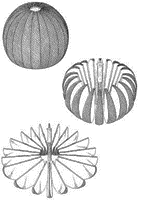
Figure 8: Kraft Foods UK Ltd. (UK 28003).
Due to its multisensory phenomena and use of technology, sonic seasoning and food plating also have copyright law implications. Under Section 101 of the Copyright Act, the term “writing” includes sound recordings, sculptures and visual works, dramatical works, musical works, pictorial works, and literary works.[109] Section 102(a) of the Copyright Act states that, in order for a work to obtain a valid copyright, it must be an original work of authorship fixed in a tangible medium of expression when it is sufficiently permanent or stable to permit it to be perceived, reproduced, or otherwise communicated for a period of more than transitory duration.[110] A work is original if it is independently created by the author, as opposed to copied from another work, and it must possess some minimal degree of creativity.[111] There are, however, several aspects of subject matter that copyright law does not protect, as is demonstrated below.
To receive copyright protection, a work must be fixed in a tangible medium of expression and be capable of being communicated or reproduced.[112] The fixation requirement is supplemental to the work of authorship in that it inquires into its transitoriness.[113] This doctrine has been applied to subject matter that is either immersive[114] or is prone to changes in nature.[115]
Perhaps one of the biggest obstacles for the copyrightability of food art and products involving sonic seasoning is the idea-expression dichotomy, which limits the scope of copyright protection by distinguishing an idea from its manifestation and provides a boundary between what belongs in the public domain and what is eligible for copyright protection.[116] Copyright protection for an original work of authorship will not extend to “any idea, procedure, process, system, method of operation, concept, principle, or discovery, regardless of the form in which it is described, explained, illustrated, or embodied in such work.”[117] When the idea and its expression are inseparable, copying the expression will not be barred.[118] Copyright law protects expression of ideas, but not ideas themselves.[119] To hold otherwise would in effect grant a monopoly of the idea upon the copyright owner.[120] Thus, cookbook recipes are not copyrightable to the extent that they combine facts (ingredients) with a procedure (directions).[121]
Even if a work qualifies as copyrightable, the Copyright Act places a bar on protecting any functional aspects of the work.[122] In copyright law, these are often referred to as useful articles—defined as objects that have an “intrinsic utilitarian function.”[123] While the Copyright Act does not define utilitarian function,[124] it does explicitly exclude works that “merely . . . portray the appearance of the article or . . . convey information.”[125] Generally, when there are artistic aspects embedded in a “useful article,” courts employ a separability test,[126] which applies to things such as statues,[127] bicycle racks,[128] and even fashion.[129]
In his research, Professor Christopher J. Buccafussco emphasizes that multisensory intellectual property can run into issues of functionality because the sensations a work produces can create some ambiguity in characterizing whether a work is utilitarian or not:[130]
While the olfactory organ model has paved the way for how one views sonic seasoning, multisensory creations, and the power music can have on these, it does not eliminate the fact that such ingredients that make up the scale model are considered mere representations in terms of potency and flavor strength.[131]
The mixology musical scale referenced above is itself utilitarian in that it represents a sort of “Richter scale” in terms of potency and flavor strength. This is the only kind of information it conveys. Moreover, these ingredients analogously serve as “building blocks” of creation, just like a musical chord or phrase. With that said, it would seem difficult to conceptually separate these blends of ingredients as musical textures of a sound recording or a musical composition, yet alone an entire musical work.[132]
But if such a connection between the notes on a scale and culinary ingredients is discovered, could recipes qualify for copyright protection? Similarly in Meredith,[133] the Seventh Circuit held that while expression of the sense of taste is functional—and, thus, not copyrightable—the inclusion of literal or visual expression in a recipe qualifies for protection under the Copyright Act.[134] Thus, one would have to be able to conceptually separate the functional aspects of the taste and then make a connection between the artistic components of that taste and the literary or visual means of expression that are included.[135]
The interdisciplinary science of gastrophysics has much potential to evolve. Scientists have recognized that, while food science undoubtedly plays a huge role in the evolution of gastrophysics, food design and culinary artistry also constitute another crucial element. As it stands, food plating and sonic seasoning have been two of the most prominent subareas of gastrophysics that have attracted scientists, artists, and product brands. But with technological advancement, more multisensory phenomena could be uncovered. Overall, gastrophysics has the potential to reshape the way scholars and practitioners look at various aspects of intellectual property law, such as trade secret protection, patentable subject matter, non-traditional marks, and more.